Presentation




Presenter
Sasha Page
P3 Program Manager
IMG Rebel

Overview
- Purpose of Discussion Paper
- Analytical Framework and Research Approach
- Revenue Risk Sharing Mechanisms for U.S.
Purpose of Discussion Paper
- Evaluate and categorize existing revenue risk sharing mechanisms
worldwide and in U.S.
- Address how mechanisms could work in U.S.
- Address how mechanisms could work better given:
- Need to create value for money (VfM)
- Fiscal impacts
- Financing constraints (financeability)
- Ease of implementation
- Provide guidance on selection of mechanisms
Context: Financial distress in multiple U.S. toll roads over the
past decade

View
larger version of newspaper page
- Dulles Greenway, VA
- South Bay Expressway, CA
- I-495 Capital Beltway, VA
- Pocahontas Parkway, Richmond, VA
- Indiana Toll Road, IN
- SH-130, TX
- San Joaquin Hills Transportation Corridor Agency 73 toll road,
CA
- LA 1 Expressway, LA
Most promising revenue risk mechanisms for U.S. highways
- Present Value of Revenues (PVR)
- Minimum Revenue Guarantee (MRG)
- Contingent Finance Support (CFS)
- Availability Payment (AP) & Revenue Sharing
- Innovative Finance Programs (IFP)
Analytical Framework and Research Approach
Developer perspectives on revenue risk: Lenders' and Developer/equity
investors' concerns
- Lenders receive only interest (no upside) and therefore tend
to be more conservative than Developers
- Developers/equity investors bear full upside/downside revenue
risk of volatile dividend payments:
- Therefore, Developers expect commensurate return
- However, Developers/equity investors have following priorities
(1= highest), which may explain views on revenue risk
- Obtain debt financing
- Win bid and successfully operate concession
- Earn cash flows to obtain or exceed expected equity
return
Public Agency perspectives on revenue risk: Value for money vs.
access to private capital
- Value for money (VfM):
- Optimal risk allocation: risk to be transferred to party
best positioned to manage risk at lowest costs
- Revenue risk inherently difficult to manage for both parties
- Public agency possibly somewhat better positioned to accept
revenue risk as it has (some) control over regional development
- If revenue risk is transferred, Developer will either price
risk (possibly inefficient risk pricing) or may decide not to
bid
- Retaining revenue risk may therefore create VfM
- Access to private capital (financeability and fiscal impact):
- P3 can accelerate projects through access to private capital
- Fiscal perspective, based on non-recourse off-balance sheet
benefits of P3s, may encourage Agencies to transfer revenue
risk
Discussion Paper employs four criteria to evaluate revenue risk
sharing mechanisms
- Value for money: How does proposed revenue
risk sharing mechanism affect VfM? Does it follow optimal risk allocation?
- Fiscal impacts: What are fiscal impacts of
proposed revenue risk sharing mechanism? Does it allow for off-
balance sheet financing? Direct or contingent liabilities?
- Financeability: How does proposed mechanism
affect Developer's ability to finance project? Does it help attract
private capital and/or reduce cost of capital?
- Ease of implementation: How difficult is it
to monitor proposed revenue risk sharing mechanism? Potential for
unintended bidding behavior? Ease of comparison of bids in procurement
stage?
Questions?
Submit a question using the chat box
Present Value of Revenues
Present Value of Revenues (PVR): Protects Developer but requires
flexible Lenders
Toll concession ends when present value of realized revenues to Developer
equals bid PVR. End date of concession is flexible, potentially with
cap on maximum concession length.
- VfM: Developer is protected against downside
revenue scenarios, so inefficient risk pricing is unlikely
- Fiscal: No immediate impact on Agency, but
contract extension means Agency will start receiving revenues later.
- Financeability: Lenders are protected, but
Lenders need to be flexible as repayment is made
- Implementation: Gross revenues are easily monitored;
key issue is correct weighted average cost of capital (WACC) in
PVR bid and performance penalties to incentivize Developer.
PVR: Base revenues case
Developer & Agency perspective
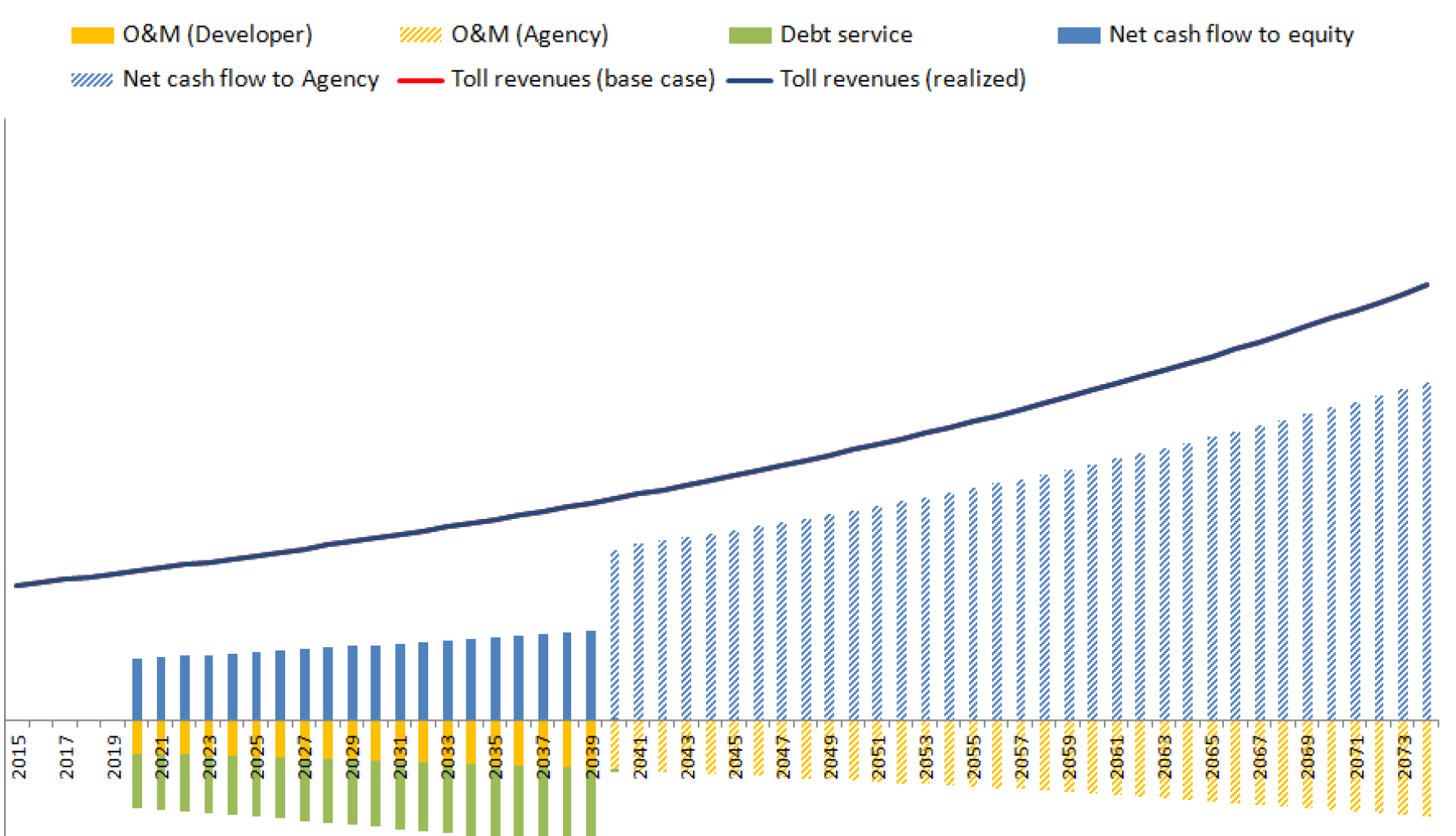
View
larger version of chart
PVR: Extreme downside revenues case
Developer perspective
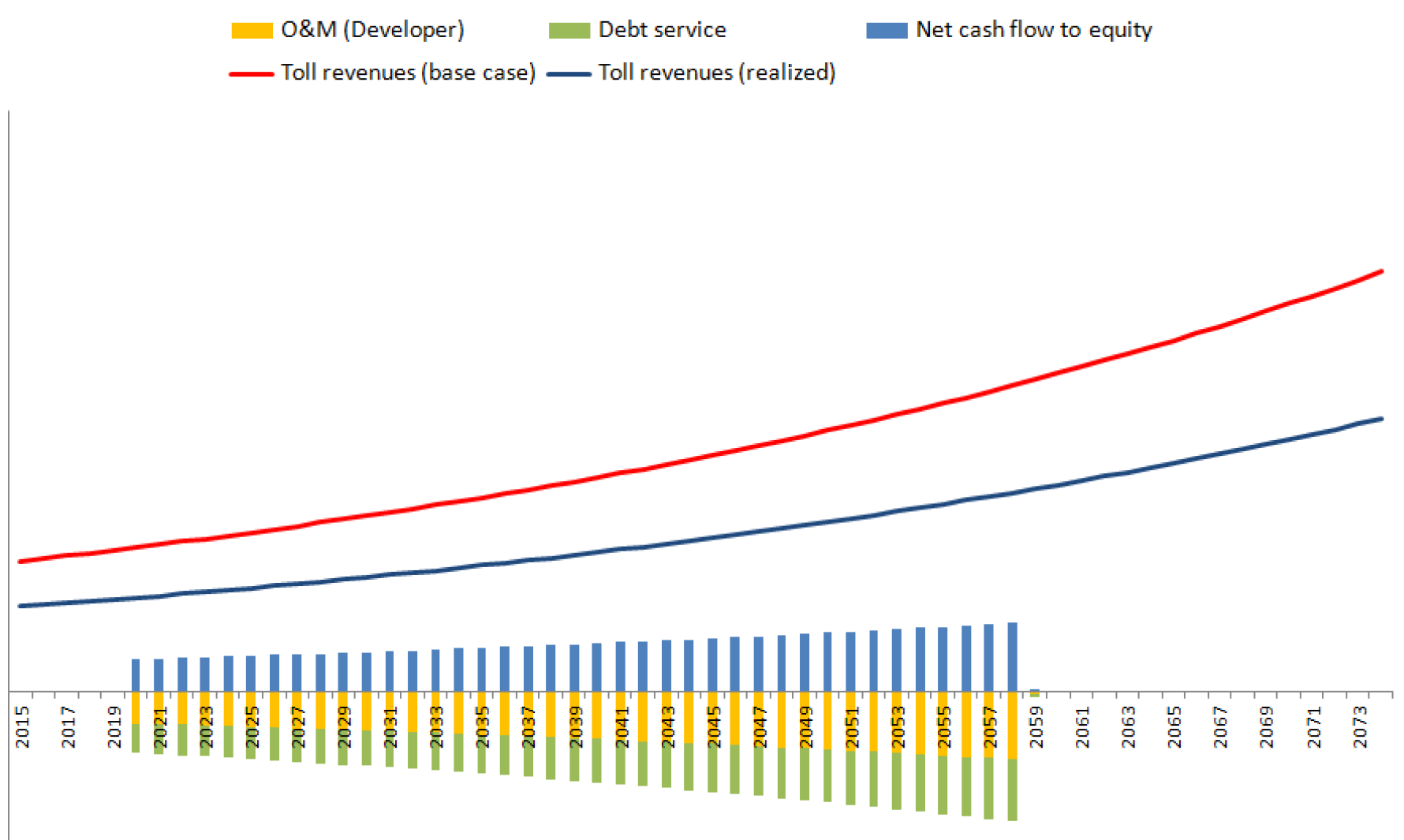
View
larger version of chart
PVR: Extreme downside revenues case
Agency perspective
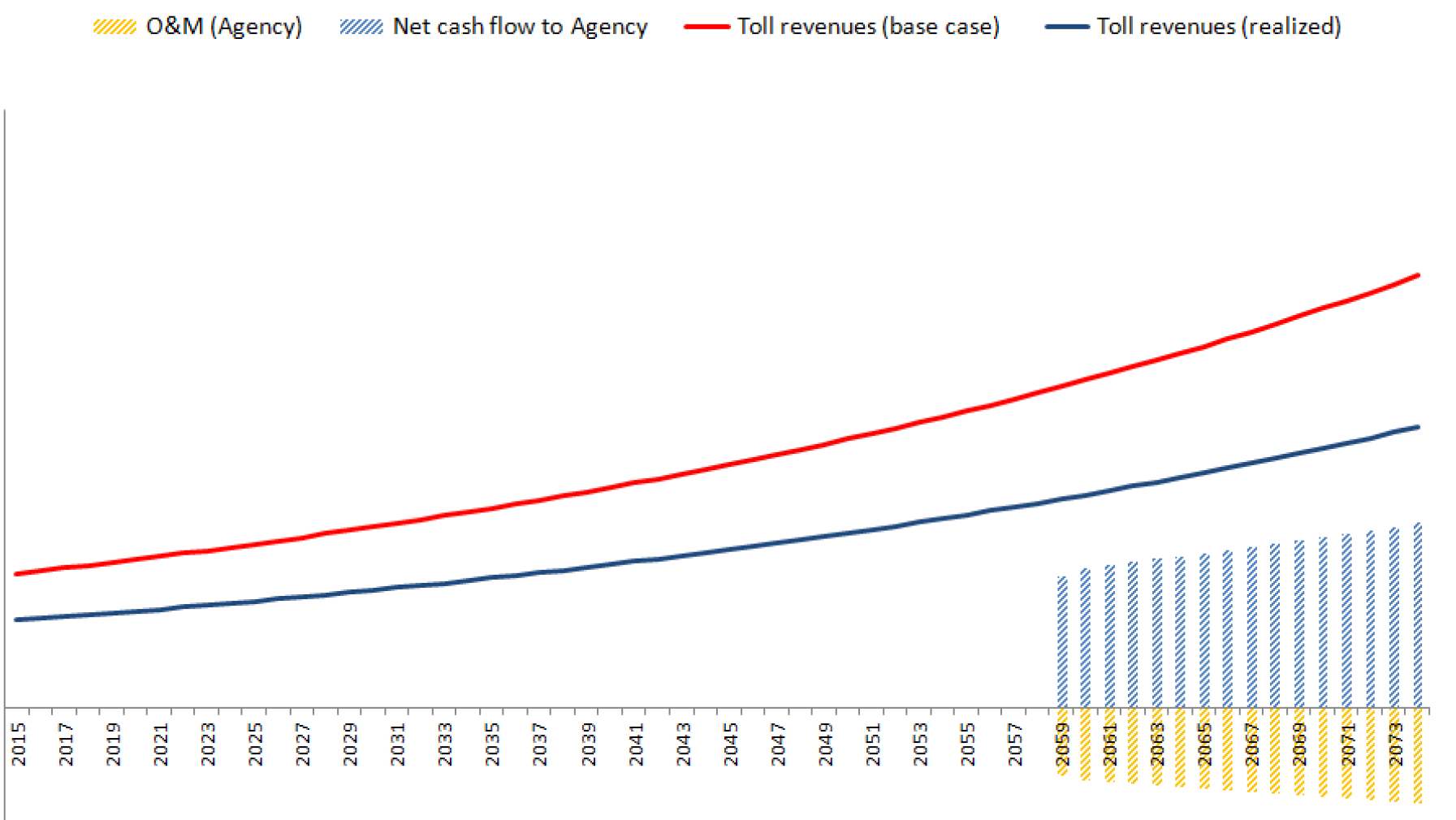
View
larger version of chart
Minimum Revenue Guarantee
Minimum Revenue Guarantee (MRG): Facilitates financing but creates
larger contingent liabilities
Agency sets minimum revenue line and pays shortfall to Developer
when realized revenues fall below guaranteed line. From reciprocity
perspective, protect not only downside, but also share in upside (revenue
sharing bands). Agencies not in position to accept significant fiscal
liabilities, combination of PVR and lower MRG could be an option.
- VfM: Developer protected so inefficient pricing
unlikely
- Fiscal: Relatively large MRG could be defensible,
yet creates immediate contingent fiscal liabilities
- Financeability: Creates certainty for Lenders
- Implementation: Very effective and transparent
mechanism that is relatively easy to implement; key challenges are
revenue guarantee level and valuation of contingent liability
MRG: Raises issues of direct vs. contingent liabilities or certain
vs. uncertain costs to Agency
- Example of direct liability: upfront subsidy to Developer (Agency will incur cost regardless of traffic)
- Example of contingent liability: Minimum Revenue Guarantee to
Developer (Agency may incur cost, depending
on realized traffic/revenue)
- Contingent liabilities can help share revenue risk between Developers
and Agencies:
- Contingent liability can cause significant fiscal burden
if traffic/revenues are lower than expected
- Uncertainty in contingent liabilities makes valuation or
fair comparison with direct liabilities difficult ($100M upfront
subsidy vs. 20 year MRG of $15M per year)
MRG: Base revenues case
Developer & Agency perspective
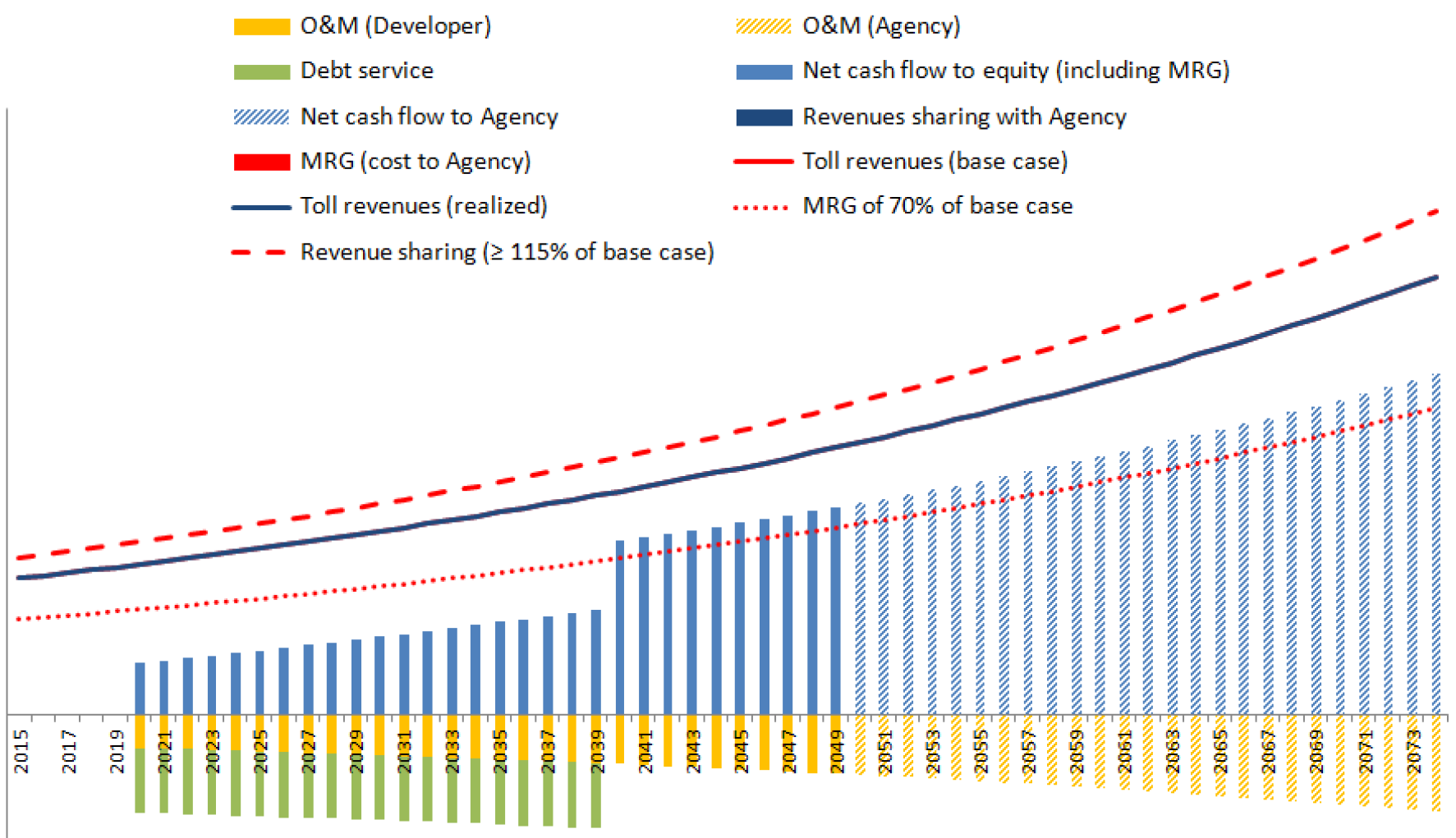
View
larger version of chart
MRG: Extreme downside revenues case
Developer perspective
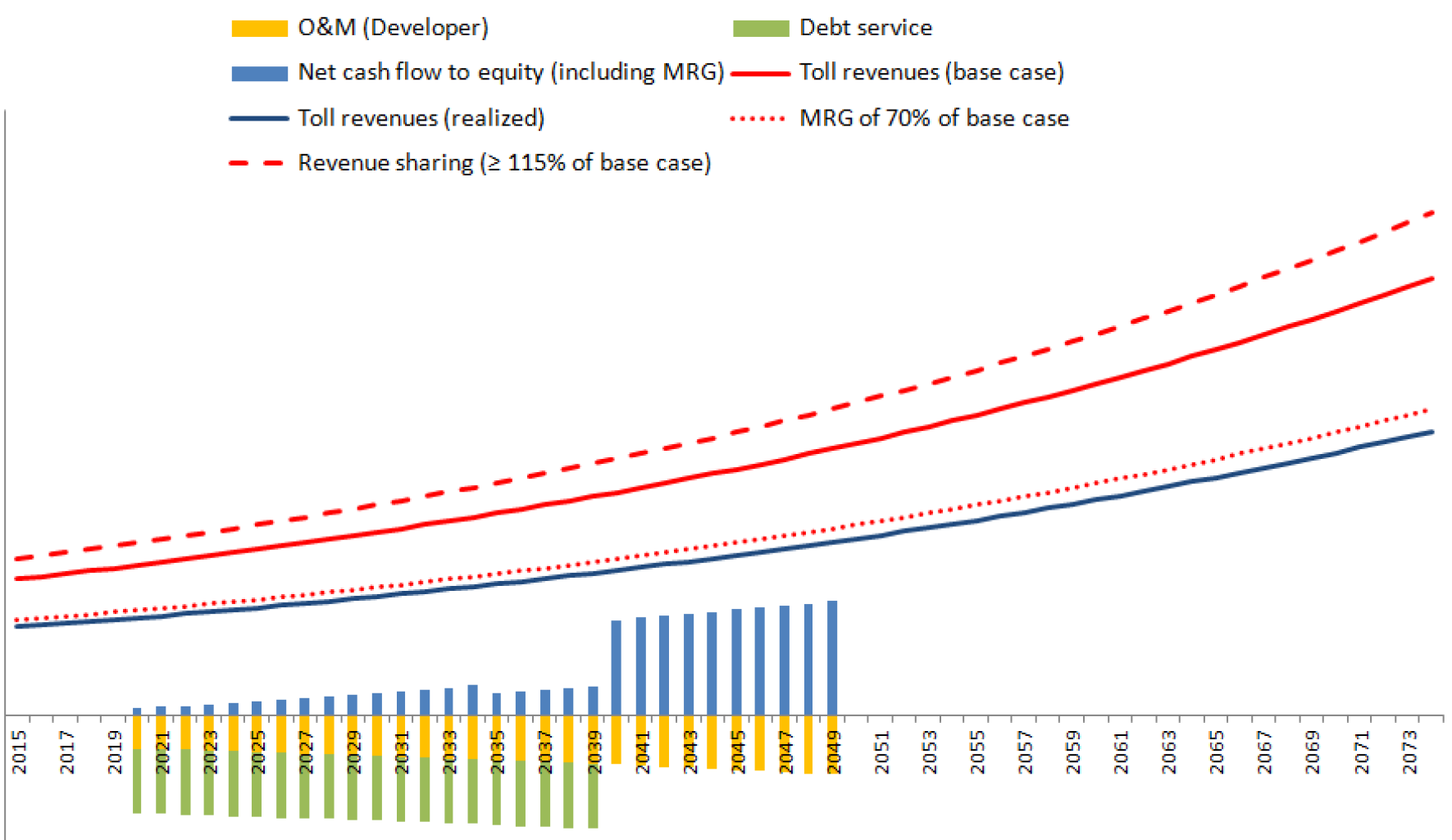
View
larger version of chart
MRG: Extreme downside revenues case
Agency perspective
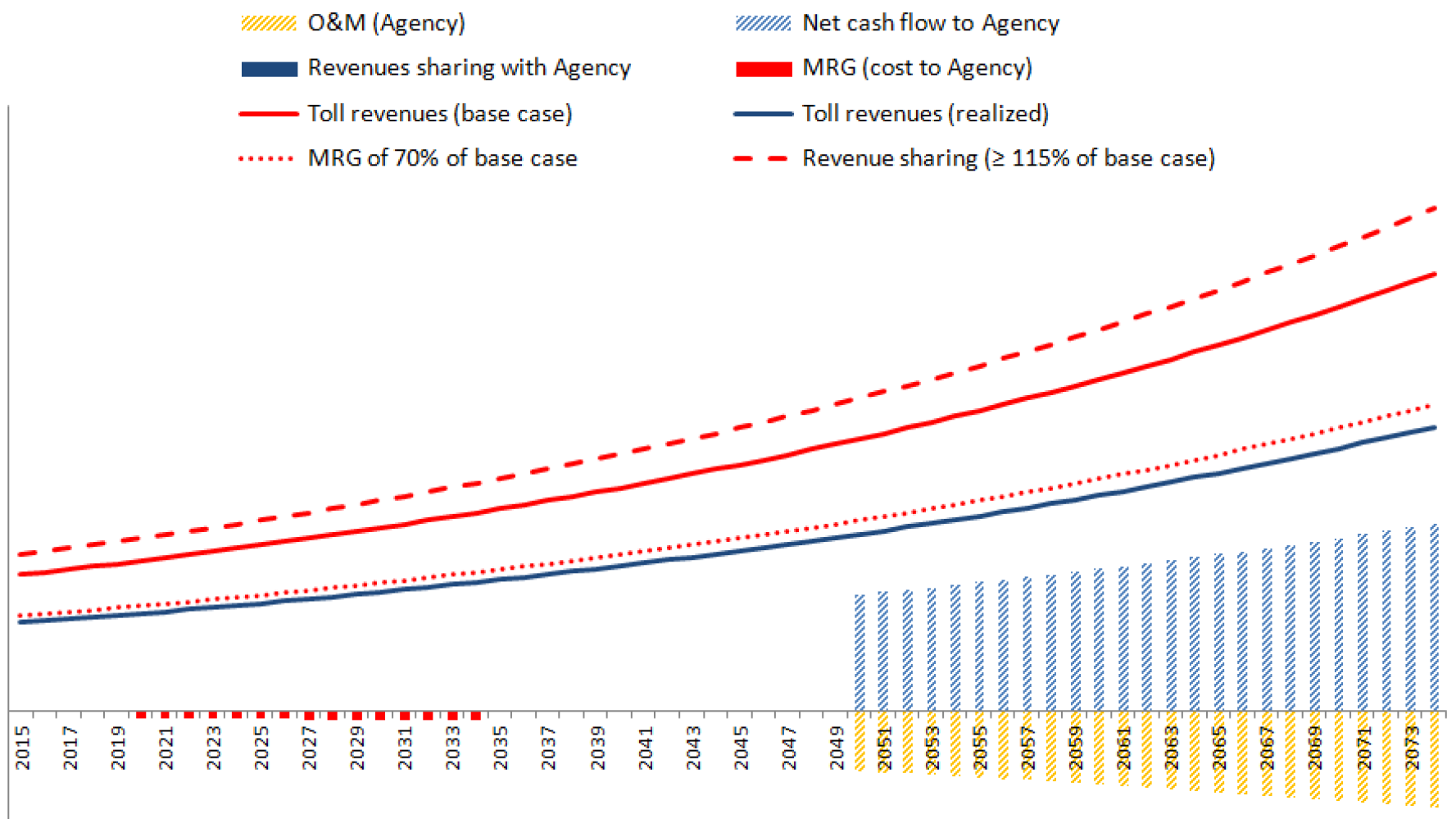
View
larger version of chart
Questions?
Submit a question using the chat box
Contingent Finance Support
Contingent Finance Support (CFS): Similar to MRG, also covering
O&M risks and being tested in U.S.
Under CFS, Agency guarantees that project will be able to re-pay
debt to Lenders, even under downside scenarios.
Similar to MRG, but downside scenarios could be caused by
1) lower than expected revenues (as under MRG) or 2) higher operating
costs.
- VfM: Sub-optimal compared to MRG since Developer
should be in best position to manage lifecycle costs
- Fiscal: Creates contingent liabilities
- Financeability: Lenders receive excellent protection
- Implementation: Being tested in U.S. market
(NC I-77) with average implementation issues; key challenges are
revenue guarantee level and valuation of contingent liability
CFS: Vase revenues case
Developer & agency perspective
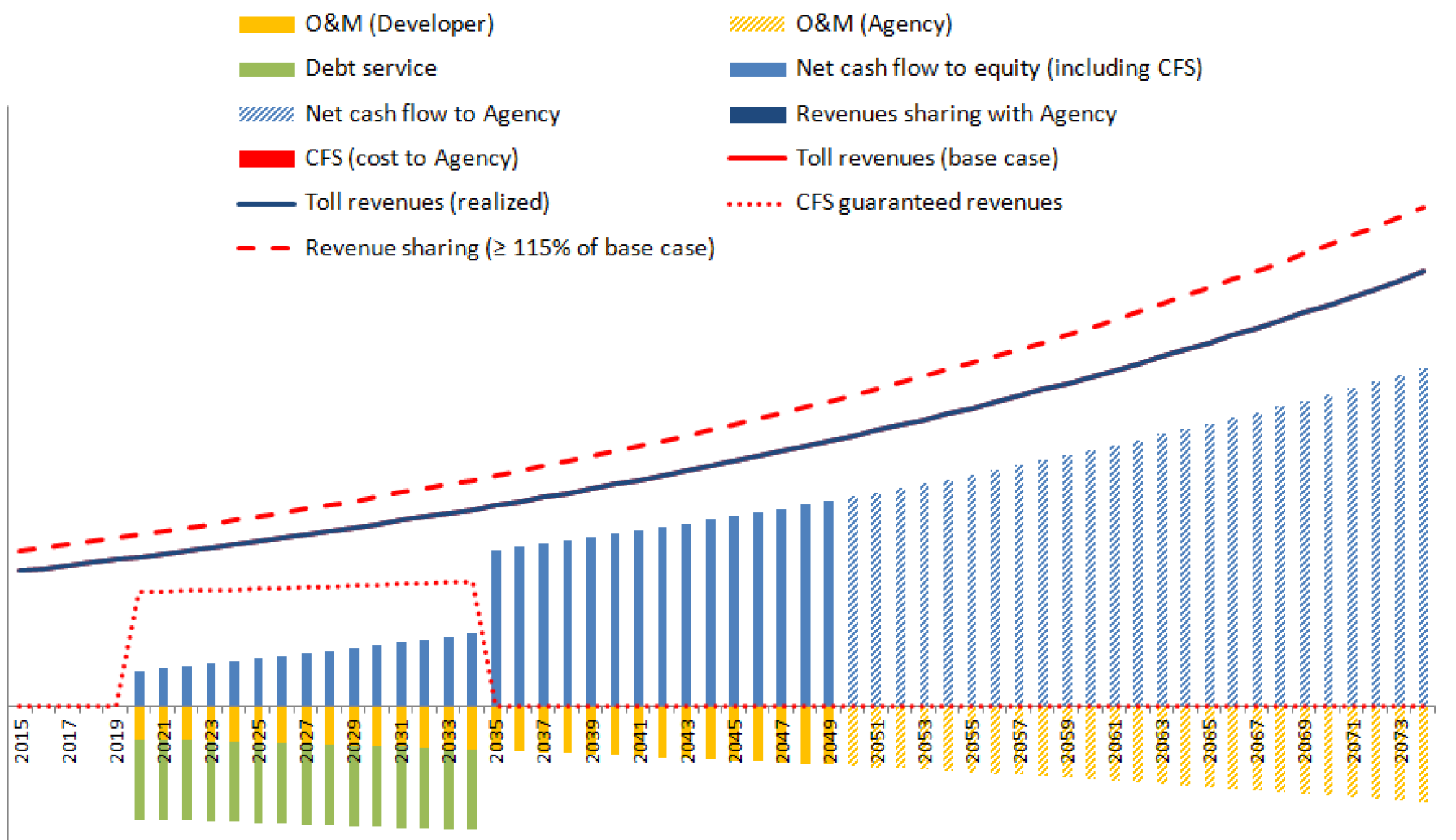
View
larger version of chart
CFS: Extreme downside revenues case
Developer perspective
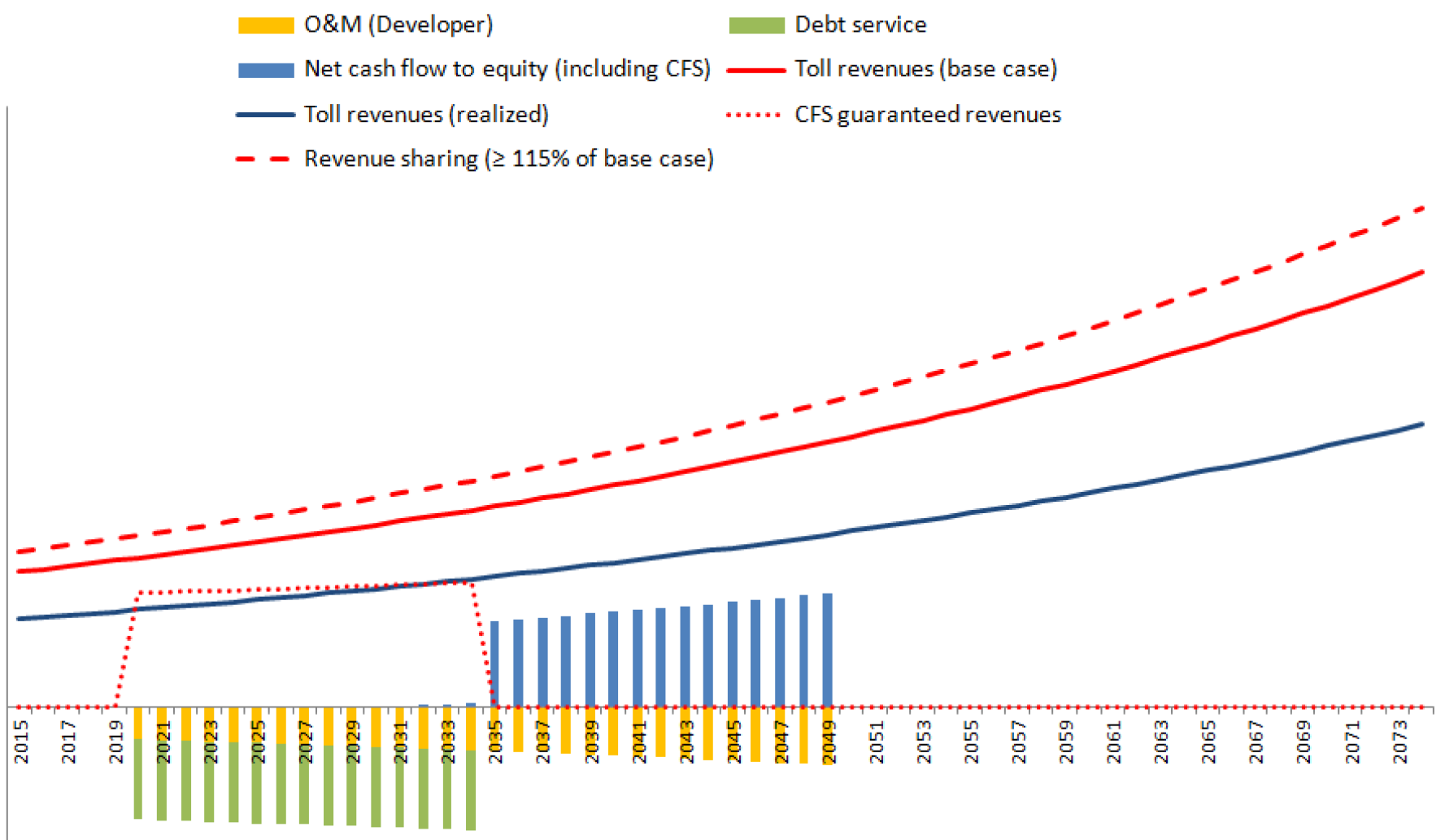
View
larger version of chart
CFS: Extreme downside revenues case
Agency perspective
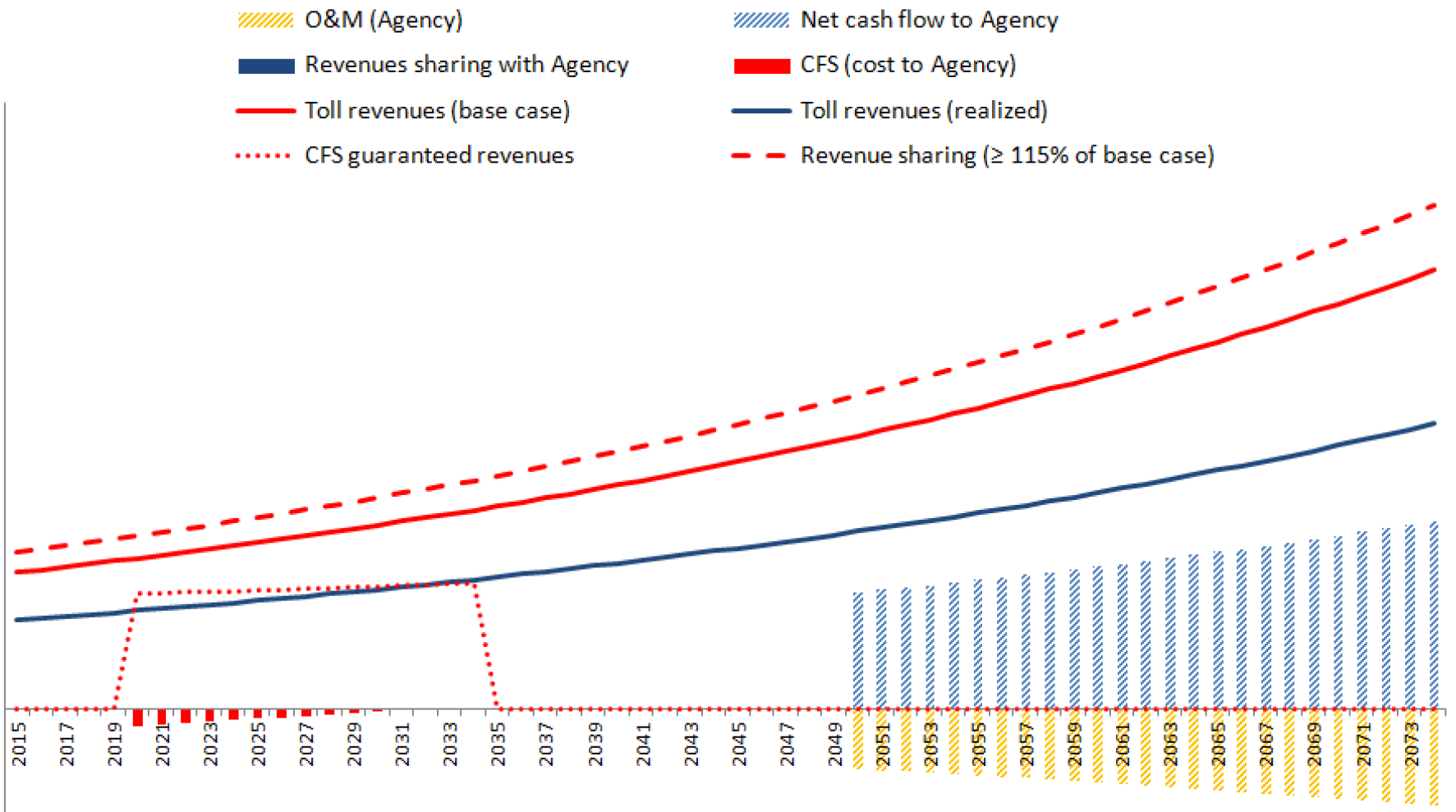
View
larger version of chart
Availability Payment with Revenue Sharing
Availability Payment (AP) with Revenue Sharing: Providing level
of certainty while sharing revenues
Developer receives AP (after performance deductions) and a share
of all realized revenues, with remainder of revenues flowing to Agency.
- VfM: AP component provides certainty to Developer
and Lenders, hence reducing inefficient risk pricing while revenue
risk exposure incentives Developer
- Fiscal: Creates long-term liabilities but also
generates future revenues for Agency
- Financeability: Improved financeability compared
to full revenue risk transfer, but credit analysis uncertainty –
AP or toll?
- Implementation: Coherent procurement strategy
required, either bid AP level or level of revenue sharing
AP with Revenue Sharing: Base revenues case
Developer & Agency perspective
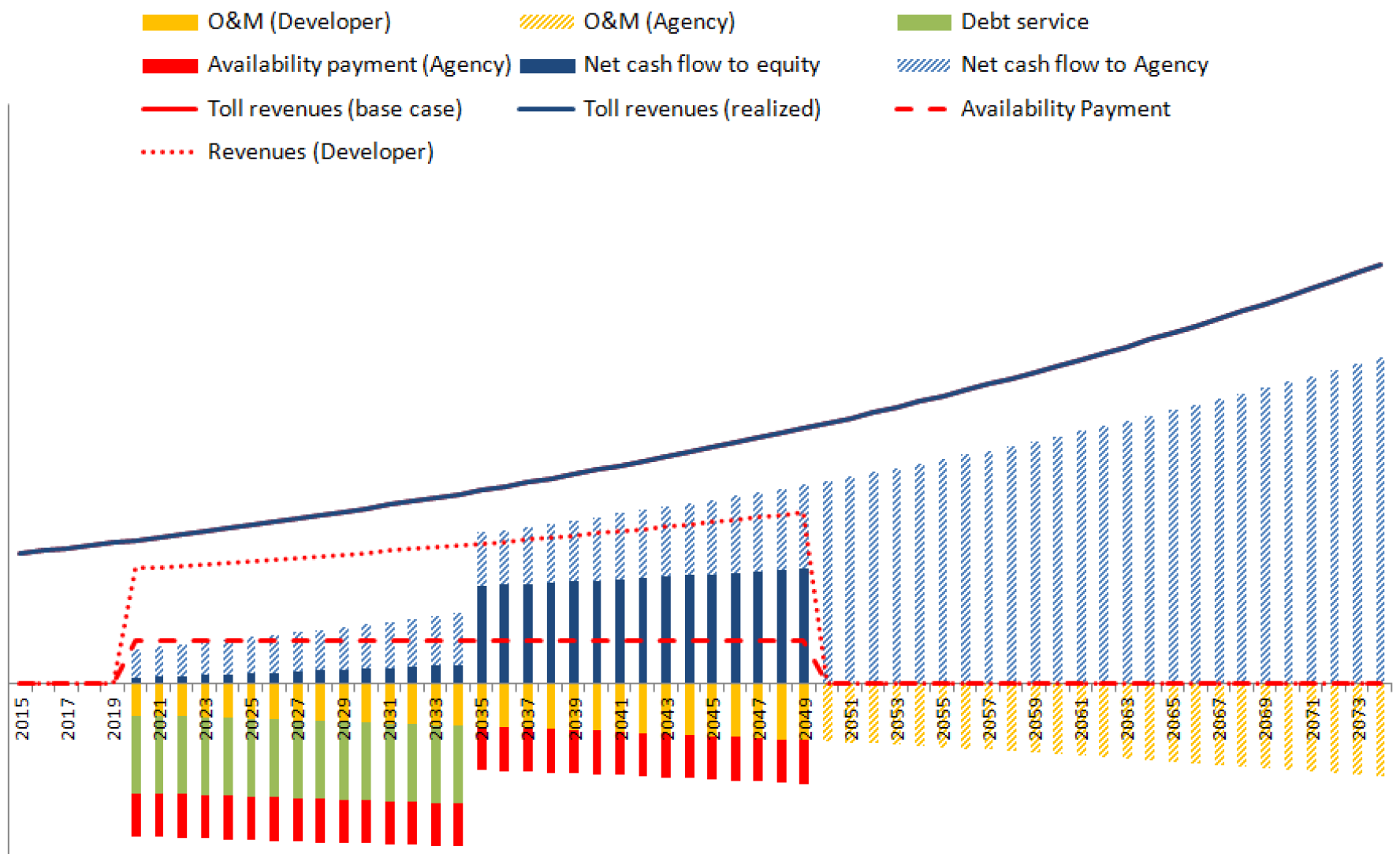
View
larger version of chart
AP with Revenue Sharing: Extreme downside revenues case
Developer perspective
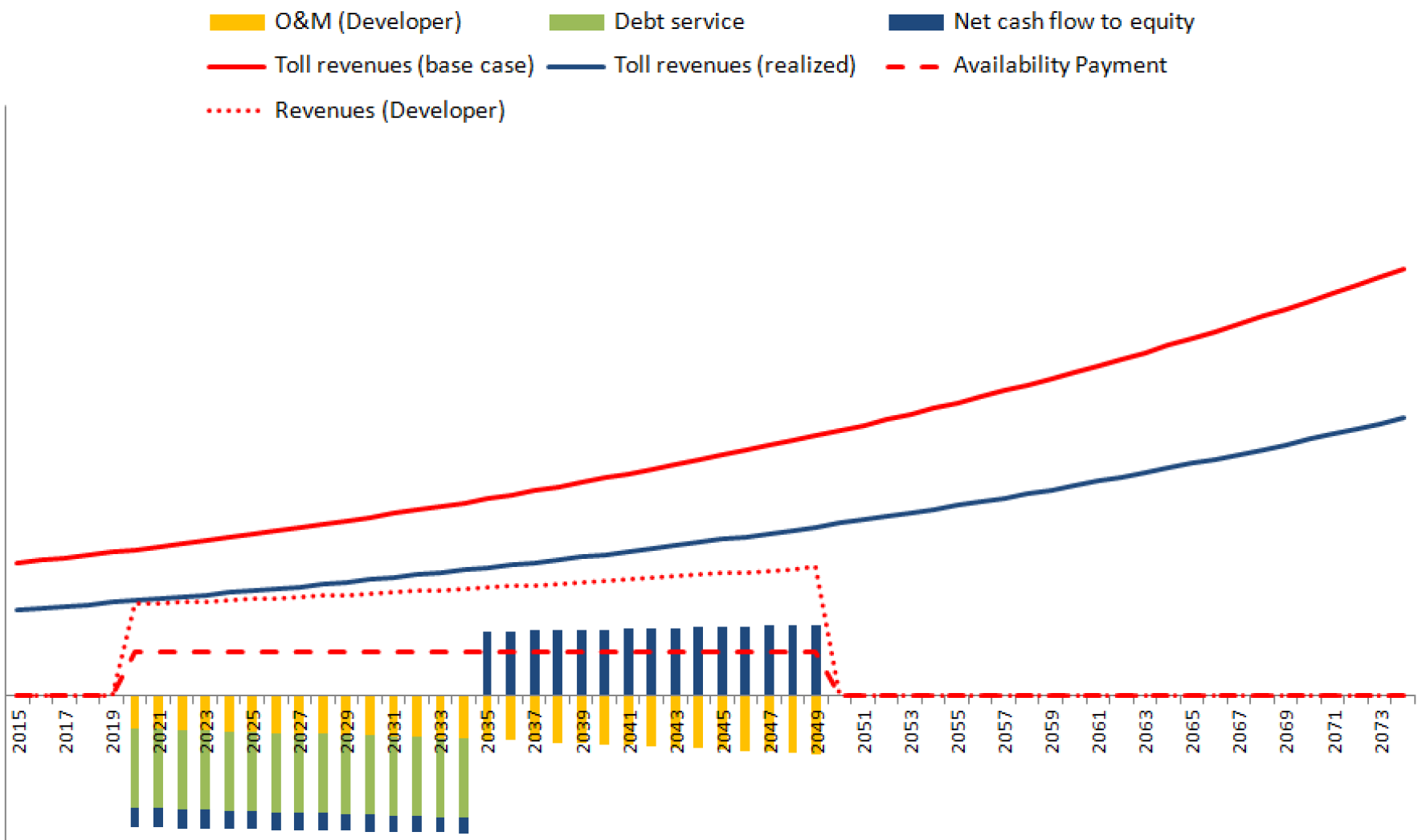
View
larger version of chart
AP with Revenue Sharing: Extreme downside revenues case
Agency perspective
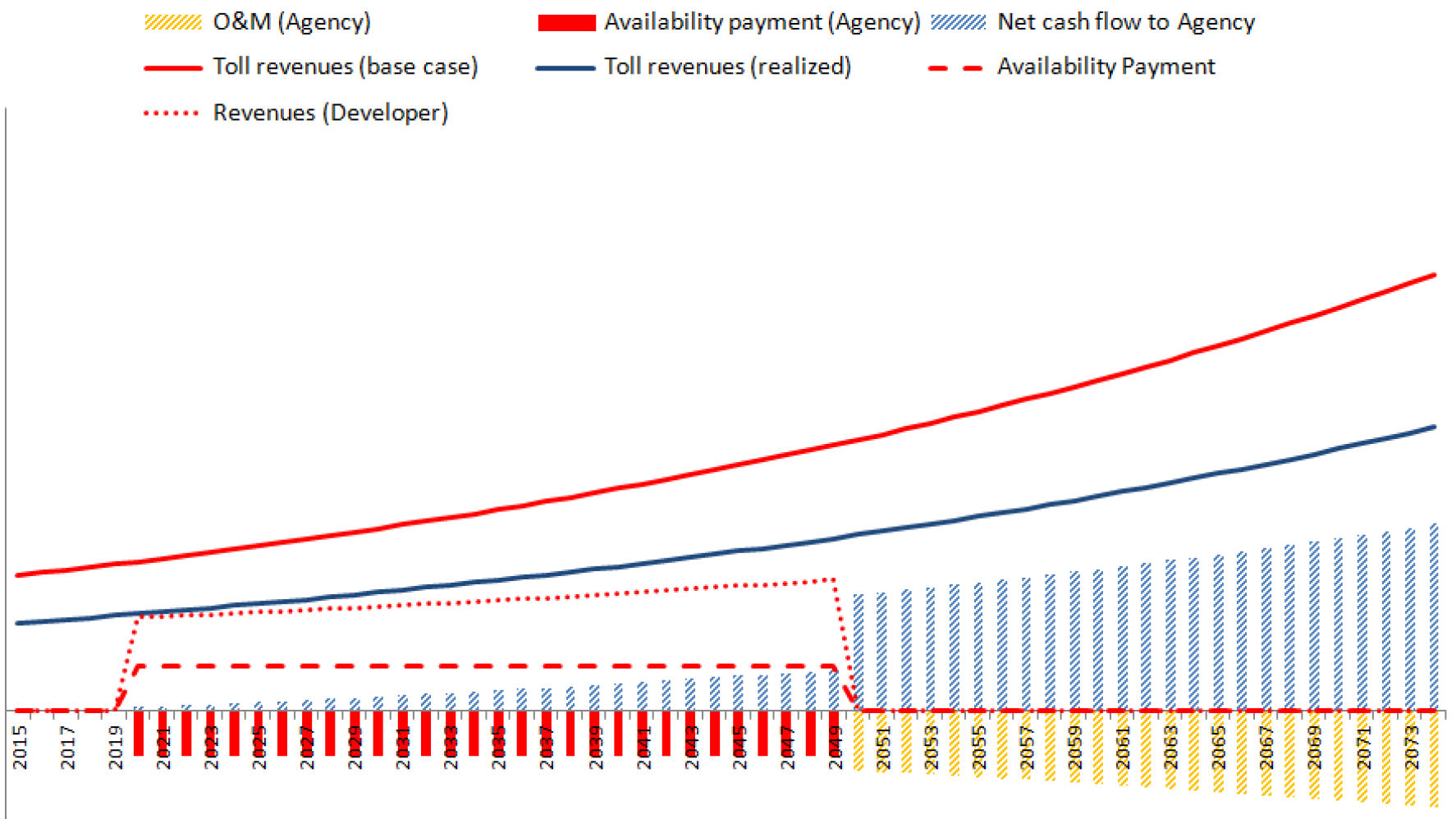
View
larger version of chart
Questions?
Submit a question using the chat box
Innovative Finance Programs
Innovative Finance Programs (IFP): Flexible financing terms to absorb
revenue risk
Flexible financing terms can reduce cash flow pressures: Mandatory
and scheduled debt service payments (as TIFIA), variable interest rates
depending on level of realized revenues.
- VfM: If Lenders can absorb (some) revenue risk,
IFP should indeed reduce inefficient risk pricing and improve VfM
- Fiscal: Projects receive implicit subsidy if
financing terms are not market-based, which may increase if interest
rate or debt service are linked to revenues (contingent liability)
- Financeability: If public Lenders were to provide
flexible financing terms, other Lenders may be better protected
- Implementation: IFPs do not pose major implementation
difficulties but may require changes in legislation
IFP Flexible Interest Rate: Base revenues case
Developer & Agency perspective
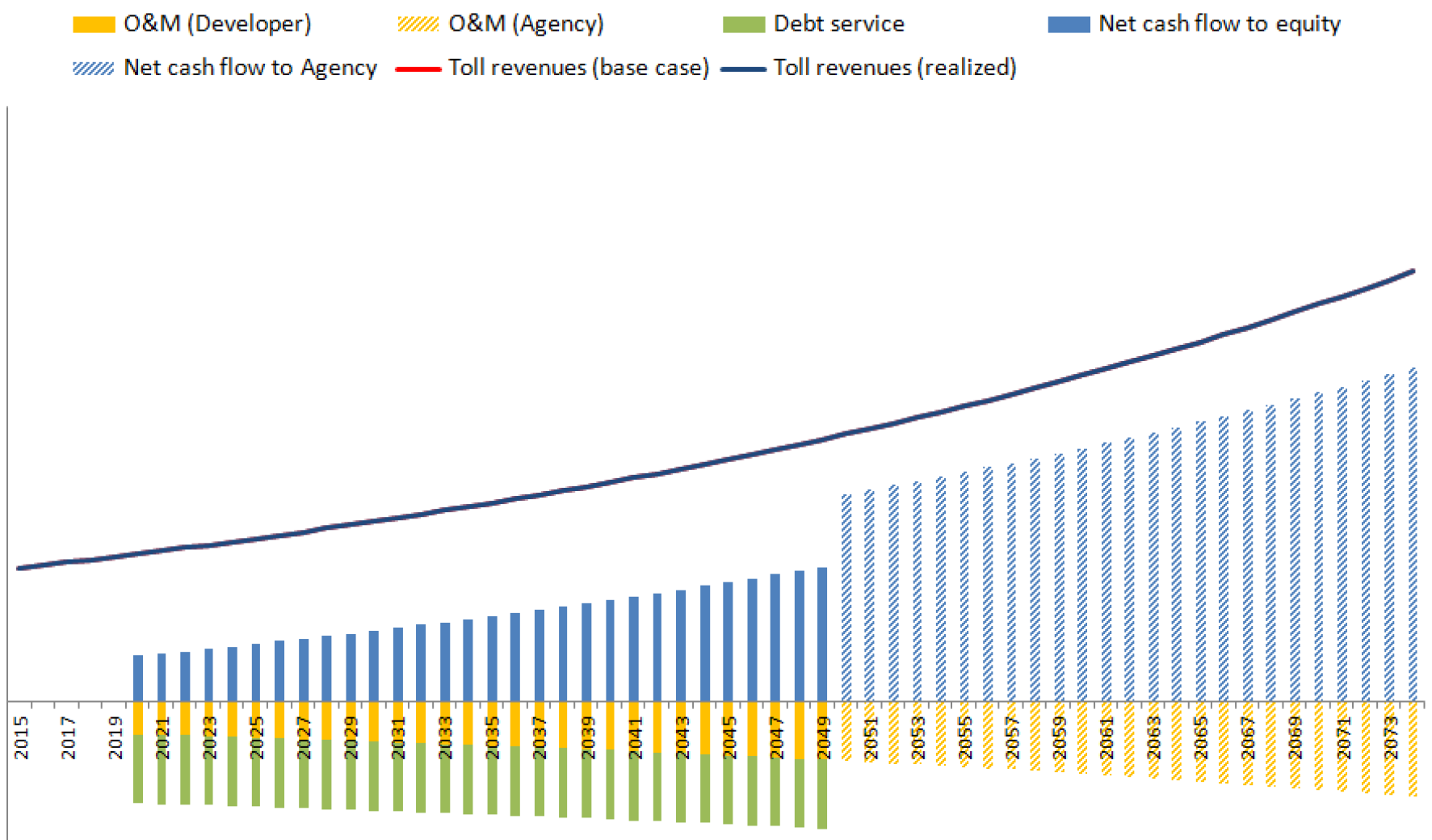
View
larger version of chart
IFP Flexible Interest Rate: Extreme downside revenues case
Developer perspective
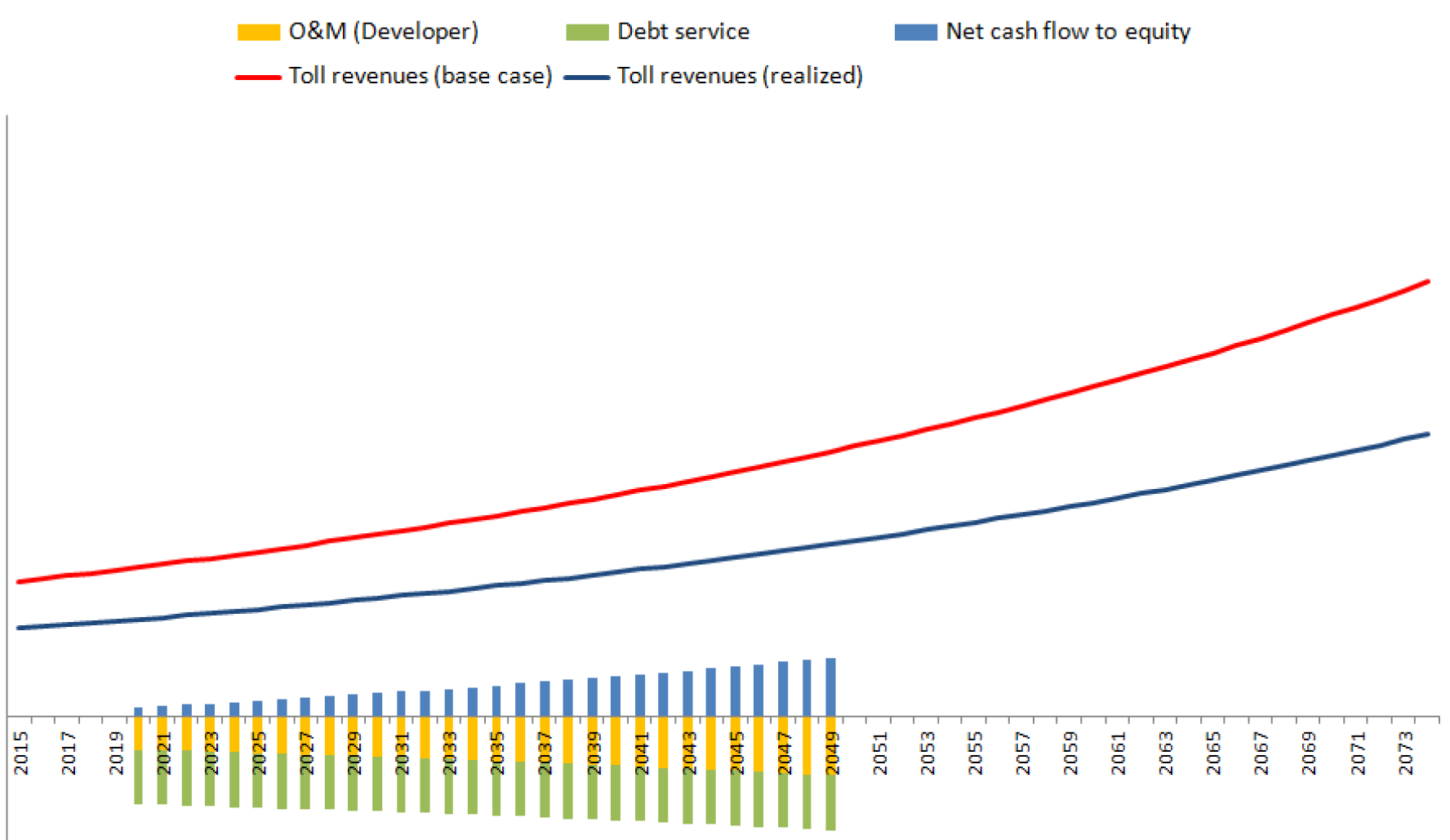
View
larger version of chart
IFP Flexible Interest Rate: Extreme downside revenues case
Agency perspective
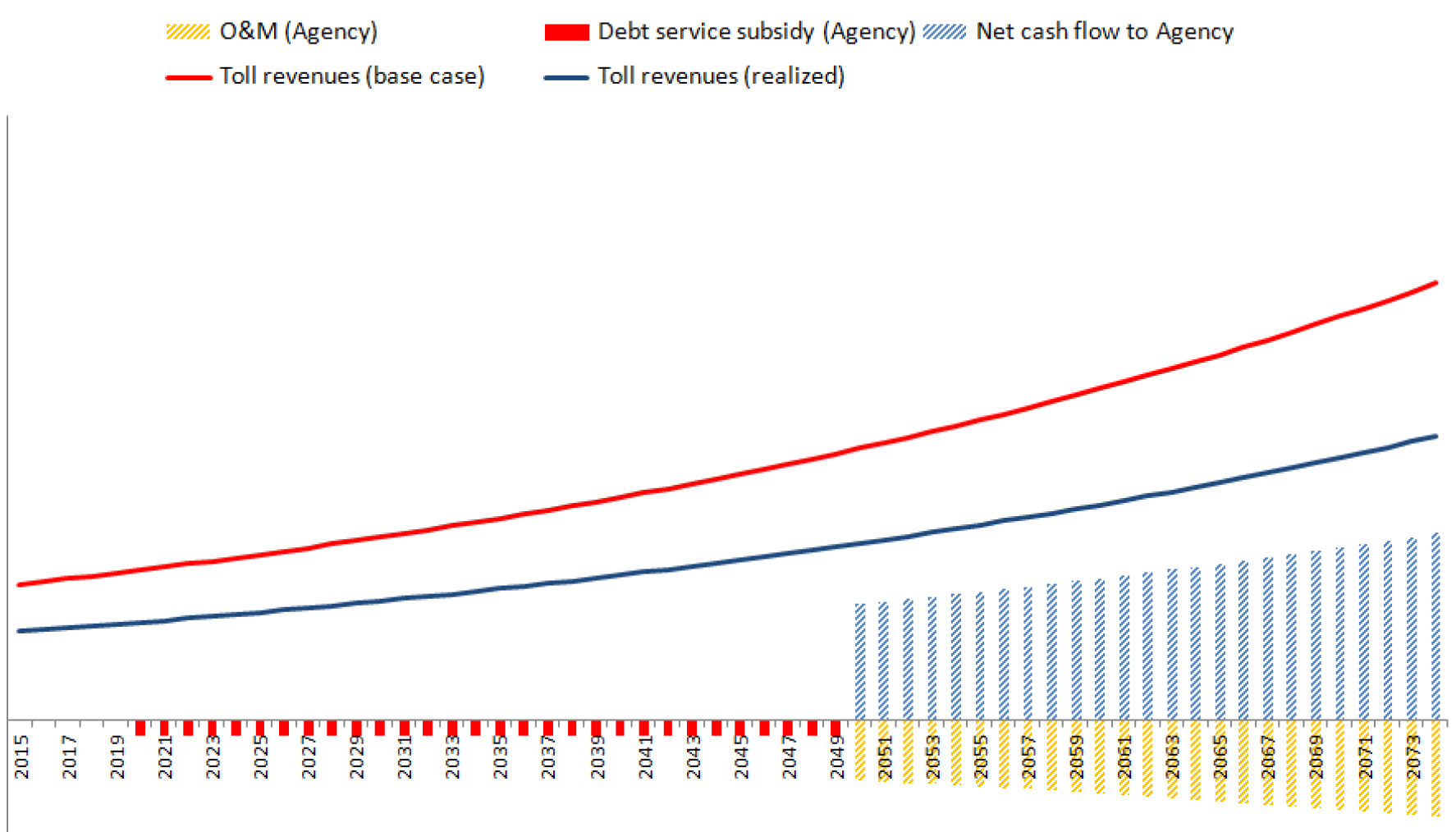
View
larger version of chart
Summary of key characteristics of revenue risk sharing mechanisms
| Criterion |
Present Value of Revenues |
Minimum Revenue Guarantee |
Contingent Finance Support |
Availability Payment & Revenue Sharing |
Innovative Finance Programs |
| Value for Money |
●●● |
●●● |
●●● |
●●● |
●● |
| Fiscal Impact |
●●● |
●● |
●● |
● |
●● |
| Financeability |
●● |
●●●● |
●●●● |
●● |
●●● |
| Ease of Implementation |
●●● |
●●●● |
●●● |
●● |
●●● |
Key: More value or benefits = ●●●● Less value or benefits = ●
Questions?
Submit a question using the chat box
Upcoming P3 Webinars
- February 2 P3 Project Financing
- February 9 Use of Performance Measures in P3s
- February 16 P3 Projects in the U.S.
To register for the webinars, please visit:
https://www.fhwa.dot.gov/ipd/p3/p3_training/webinars.aspx
Contact Information
IMG Rebel
Sasha Page - SPage@imgrebel.com
Wim Verdouw - WVerdouw@imgrebel.com
Marcel Ham - MHam@imgrebel.com
4390 East West Highway, Suite 950
Bethesda, MD 20814
Office:
(301) 907-2900
https://www.rebelgroup.com/en/offices/united-states/
Patrick DeCorla-Souza
P3 Program Manager
USDOT Build America Bureau
& FHWA Center for Innovative Finance Support
(202) 366-4076
Patrick.DeCorla-Souza@dot.gov




